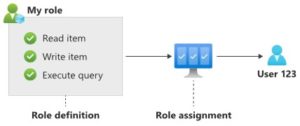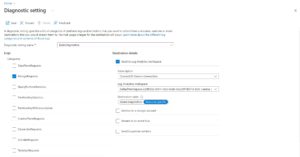Role based access control (RBAC) is a much-needed capability in any database for enterprises. It lets you simplify your access control mechanism without added management. We have introduced RBAC in Azure Cosmos DB API for MongoDB, which allows you to:
- Authorize your data requests with a fine-grained, role-based permission model
- Audit your diagnostic logs to retrieve the user identity for each database operation
How does it work?
API for MongoDB RBAC is built on concepts that are commonly found in other RBAC systems like Azure RBAC, including:
- Role definition is a set of actions that one can perform using a given role. These actions map to database operations like read, write, etc. There are built-in roles like “read” and you can create custom roles as well
- User is the identity represented by a username and password
- The user is then mapped to a role through role assignment, this user can perform every action defined in the role definition of the mapped role
How to get started?
Using RBAC is a simple 4 step process.
1. Enable RBAC on Azure Cosmos DB API for MongoDB
To use RBAC in API for MongoDB, you need to enable this capability in your Azure Cosmos DB account.
Azure CLI
az cloud set -n AzureCloud az login az account set --subscription <your subscription ID> az cosmosdb update -n <account_name> -g <azure_resource_group> --capabilities EnableMongoRoleBasedAccessControl
2. Create user definition
Create user definition with built-in read role definition. There are other built-in roles defined by the system, you can check them out here.
Azure CLI
#!/bin/bash
account_name=<YOUR_DB_ACCOUNT>
rg=<YOUR_RG>
db=<YOUR_DB_NAME>
username=<YOUR_USERNAME>
password=<YOUR_PASSWORD>
printf '{
"Id": "'"$db.$username"'",
"UserName": "'"$username"'",
"Password": "'"$password"'",
"DatabaseName": "'"$db"'",
"CustomData": "some_random_info",
"Mechanisms": "SCRAM-SHA-256",
"Roles": [{
"Role": "read",
"Db": "'"$db"'"
}]
}'>create_user.json
az cosmosdb mongodb user definition create --account-name $account_name --resource-group $rg --body @create_user.json
3. Test RBAC
You are now ready to use your account using RBAC. Authenticate the client using the username and password provided in creating the user.
Python
from pymongo import MongoClient
client = MongoClient("mongodb://<USERNAME>:<PASSWORD>@<YOUR_HOSTNAME>:10255/?ssl=true&replicaSet=globaldb&retrywrites=false&maxIdleTimeMS=120000", username="<YOUR_USER>", password="<YOUR_PASSWORD>", authSource='<YOUR_DATABASE>', authMechanism='SCRAM-SHA-256', appName="<YOUR appName FROM CONNECTION STRING IN AZURE PORTAL>")
db = client[“<your_database_name>”]
col = db[“<your_collection_name>”]
for doc in col.find({}):
print(doc)
4. Audit your requests
Users can audit the operation performed on the database by enabling diagnostics logging. See, Monitor Azure Cosmos DB data by using Azure Diagnostic settings | Microsoft Docs
Select MongoRequests table in the diagnostics logs settings, this table contains UserId column against each request. This column would be blank for accounts not using RBAC.
Use below query to find out the users performing the requests.
KQL (Kusto Query Language)
CDBMongoRequests | where OperationName == "Find" | project DatabaseName, CollectionName, UserId, TimeGenerated
Next steps
Create custom role definitions
You can create a new role definition if you need to define custom set of permissions. Checkout full list of Azure CLI commands here.
Azure CLI
#!/bin/bash
account_name=<YOUR_DB_ACCOUNT>
rg=<YOUR_RG>
db=<YOUR_DB_NAME>
role_name=<YOUR_ROLE_NAME>
collection_name=<COLLECTION_NAME>
printf '{
"Id": "'"$db.$role_name"'",
"RoleName": "'"$role_name"'",
"Type": "CustomRole",
"DatabaseName": "'"$db"'",
"CustomData": "some_random_info",
"Privileges":[
{
"Resource":{
"Db": "'"$db"'",
"Collection": "'"$collection_name"'"
},
"Actions": [
"insert",
"find"
]
}
],
"Roles":[]
}'>create_role.json
az cosmosdb mongodb role definition create --account-name $account_name --resource-group $rg --body @create_role.json
Enforcing RBAC as the only authentication method
Disable any other auth mechanism for Azure Cosmos DB by updating the ARM template. Add the following property in your existing template or create a new one.
JSON
"resources": [
{
"type": " Microsoft.DocumentDB/databaseAccounts",
"properties": {
"disableLocalAuth": true,
},
},
]
Learn more
The granularity of this permission model lets you control very precisely what a client is allowed to do. Moreover, you can always come back to audit logs and identify what operation was issued by which user in case of any dilemma.
- To find out more about current capabilities, limitations, and code samples check out our official documentation.
- Discover additional features and capabilities about Azure Cosmos DB and get started for free.




Enforcing RBAC as the only authentication method does not work for MongoDB.
Thank you, excellent post. But the last part is not working.
After trying to follow the section for disabling localAuth, I get this error:
Status Message: DisableLocalAuth is only allowed to be configured for SQL API account. ActivityId: 622fb39b-456d-4679-b446-d3f2df1026cd, Microsoft.Azure.Documents.Common/2.14.0 (Code:BadRequest) CorrelationId: 0c4e5847-1d3c-4621-b10d-5e01c9b57e67
I tried re-deploying the database using ARM or by running the command:
az resource update --ids $cosmosdb.id --set properties.disableLocalAuth=true --latest-include-preview
It is an issue because the keys are still allowing connections to MongoDB even if we are using RBAC.
Thank you.